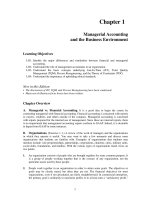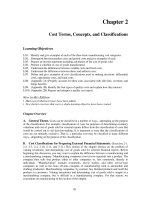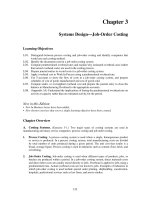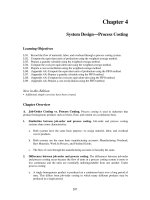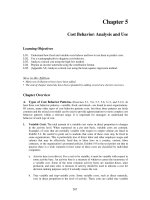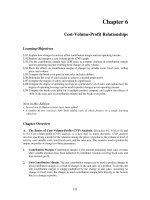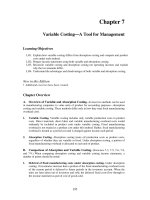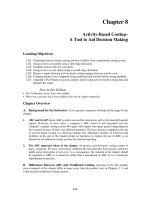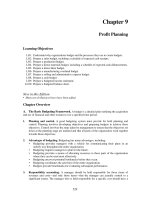Overview managerial accounting chapter 02
Bạn đang xem bản rút gọn của tài liệu. Xem và tải ngay bản đầy đủ của tài liệu tại đây (3.14 MB, 72 trang )
Chapter 2
Cost Terms, Concepts, and Classifications
Learning Objectives
LO1.
LO2.
LO3.
LO4.
LO5.
LO6.
LO7.
Identify and give examples of each of the three basic manufacturing cost categories.
Distinguish between product costs and period costs and give examples of each.
Prepare an income statement including calculation of the cost of goods sold.
Prepare a schedule of cost of goods manufactured.
Understand the differences between variable costs and fixed costs.
Understand the differences between direct and indirect costs.
Define and give examples of cost classifications used in making decisions: differential
costs, opportunity costs, and sunk costs.
LO8. (Appendix 2A) Properly account for labor costs associated with idle time, overtime, and
fringe benefits.
LO9. (Appendix 2B) Identify the four types of quality costs and explain how they interact.
LO10. (Appendix 2B) Prepare and interpret a quality cost report.
New in this Edition
• Many new In Business boxes have been added.
• New shorter exercises that cover a single learning objective have been created.
Chapter Overview
A. General Theme. Costs can be classified in a number of ways—depending on the purpose
of the classification. For example, classification of costs for purposes of determining inventory
valuations and cost of goods sold for external reports differs from the classification of costs that
would be carried out to aid decision-making. It is important to note that the classifications of
costs are not mutually exclusive. That is, a particular cost may be classified in many different
ways—depending on the purpose of the classification.
B. Cost Classifications for Preparing External Financial Statements. (Exercises 2-1,
2-2, 2-3, 2-4, 2-10, 2-11, and 2-12.) This section of the chapter focuses on the problem of
valuing inventories and determining cost of goods sold for external financial reports. Before
beginning this discussion, you may want to explain the difference between a manufacturing and
a merchandising company. Manufacturing companies convert raw materials into a product. The
company then sells that product either to other companies or, less commonly, directly to
individuals. “Manufacturing” includes restaurants, movie studios, and other service-type
companies as well as the more obvious examples of manufacturing such as automobile and
clothing production. Merchandising companies, by contrast, buy finished products and resell the
products to customers. Valuing inventories and determining cost of goods sold is simple in a
merchandising company, but is difficult in a manufacturing company. For that reason, we
concentrate on manufacturing in this section of the chapter.
61
1.
Manufacturing costs. These costs are incurred to make a product. Manufacturing costs are
usually grouped into three main categories: direct materials, direct labor, and
manufacturing overhead.
a. Direct materials. Direct materials consist of those raw material inputs that become an
integral part of a finished product and can be easily traced into it. Examples include the
aircraft engines on a Boeing 777, the Intel processing chip in a personal computer, and
the blank video cassette in a pre-recorded video.
b. Direct Labor. Direct labor consists of that portion of labor cost that can be easily traced
to a product. Direct labor is sometimes referred to as “touch labor” since it consists of
the costs of workers who “touch” the product as it is being made.
c. Manufacturing Overhead. Manufacturing overhead consists of all manufacturing costs
other than direct materials and direct labor. These costs cannot be easily and
conveniently traced to products. Examples include miscellaneous supplies such as
rivets in a Boeing 777, supervisors, janitors, factory facility charges, etc.
d. Prime versus Conversion Costs. Prime cost consists of direct materials plus direct
labor. Conversion cost consists of direct labor plus manufacturing overhead.
2.
Non-manufacturing costs. A manufacturing company incurs many other costs in addition
to manufacturing costs. For financial reporting purposes most of these other costs are
typically classified as selling (marketing) costs and administrative costs. Marketing and
administrative costs are incurred in both manufacturing and merchandising firms.
a. Marketing Costs. These costs include the costs of making sales, taking customer orders,
and delivering the product to customers. These costs are also referred to as ordergetting and order-filling costs.
b. Administrative Costs. These costs include all executive, organizational, and clerical
costs that are not classified as production or marketing costs.
3.
Period vs. product costs. Costs can also be classified as period or product costs.
a. Period Costs. Period costs are expensed in the time period in which they are incurred.
All selling and administrative costs are typically considered to be period costs. You
should be careful to point out that the usual rules of accrual accounting apply. For
example, administrative salary costs are “incurred” when they are earned and not
necessarily when they are paid to employees.
b. Product Costs. Product costs are added to units of product (i.e., “inventoried”) as they
are incurred and are not treated as expenses until the units are sold. This can result in a
delay of one or more periods between the time in which the cost is incurred and when it
appears as an expense on the income statement. Product costs are also known as
inventoriable costs. The discussion in the chapter follows the usual interpretation of
GAAP in which all manufacturing costs are treated as product costs.
4.
Inventory valuations and Cost of Goods Sold. In a manufacturing company, raw
materials purchases are recorded in a raw materials inventory account. These costs are
62
transferred to a work in process inventory account when the materials are released to the
production departments. Other manufacturing costs—direct labor and manufacturing
overhead—are charged to the work in process inventory account as incurred. As work in
process is completed, its costs are transferred to the finished goods inventory account.
These costs become expenses only when the finished goods are sold. Period expenses are
taken directly to the income statement as expenses of the period.
5.
Schedule of Cost of Goods Manufactured. Because of inventories, the cost of goods sold
for a period is not simply the manufacturing costs incurred during the period. Some of the
cost of goods sold may be for units completed in a previous period. And some of the units
completed in the current period may not have been sold and will still be on the balance
sheet as assets. The cost of goods sold is computed with the aid of a schedule of costs of
goods manufactured, which takes into account changes in inventories. The schedule of cost
of goods manufactured is not ordinarily included in external financial reports, but must be
compiled by accountants within the company in order to arrive at the cost of goods sold.
You should take some time to explain the cost of goods manufactured schedule since it is
often difficult for students to understand.
C. Cost Classifications to Describe Cost Behavior. (Exercises 2-5 and 2-11.) Managers
often need to be able to predict how costs will change in response to changes in activity. The
activity might be the output of goods or services or it might be some measure of activity internal
to the company such as the number of purchase orders processed during a period. In this chapter,
nearly all of the illustrations assume that the activity is the output of goods or services. In later
chapters, other measures of activity will be introduced.
While there are other ways to classify costs according to how they react to changes in
activity, in this chapter we introduce the simple variable and fixed classifications. A variable
cost is constant per unit of activity but changes in total as the activity level rises and falls. A
fixed cost is constant in total for changes in activity within the relevant range. (Just about any
cost will change if there is a big enough change in activity. Fixed costs do not change for
changes in activity that fall within the “relevant range.”) When expressed on a per unit basis, a
fixed cost is inversely related to activity—the per unit cost decreases when activity rises and
increases when activity falls.
There is some controversy concerning the proper definition of the “relevant range.” Some
refer to the relevant range as the range of activity within which the company usually operates.
We refer to the relevant range as the range of activity within which the assumptions about
variable and fixed costs are valid. Either definition could be used—our choice was dictated by
our desire to highlight the notion that fixed costs can change if the level of activity changes
enough.
D. Cost Classifications for Assigning Costs. (Exercise 2-6.) Managers often want costs
to be assigned to “cost objects” such as products, customers, departments, etc. for pricing or
other purposes. A direct cost is a cost that can be conveniently and easily traced to a particular
cost object. Indirect costs are everything else. A cost would be considered indirect for one of two
reasons: either it is impractical or it is impossible to trace the cost to the cost object.
1.
Common costs. For example, it is impossible to trace the factory managers’ salary in a
multi-product plant to any particular product made in the plant. Even if a product were
dropped entirely, we would ordinarily expect the factory manager’s salary to remain the
same. This is an example of a “common cost” and later in the text we emphasize that such
costs should not be allocated for decision-making or performance evaluation purposes.
63
2.
Variable indirect costs. On the other hand, other costs are treated as indirect costs because
it would not be practical to treat them otherwise. For example, it would be possible to
measure the precise amount of solder used on each circuit board produced at a HP plant,
but it wouldn’t be worth the effort. Instead, solder would typically be considered an indirect
material and would be included in overhead.
E. Cost Classifications for Decision-Making. (Exercise 2-7.) Every decision involves
choosing from among at least two alternatives. Only those costs and benefits that differ between
alternatives are relevant in making the selection. This concept is explored in greater detail in the
chapter on relevant costs. However, decision-making contexts crop up from time to time in the
text before that chapter, so it is a good idea to familiarize students with relevant cost concepts.
1.
Differential Costs. A differential cost is a cost that differs between alternatives. The cost
may exist in only one of the alternatives or the total amount of the cost may differ between
the alternatives. In the latter case, the differential cost would be the difference between the
cost under one alternative and the cost under the other. Differential costs are also called
incremental costs. Differential costs and opportunity costs should be the focus of decisionmaking. They are the only relevant costs and all others should be ignored.
2.
Opportunity Costs. An opportunity cost is the potential benefit that is given up by
selecting one alternative over another. The concept of an opportunity cost is rather difficult
for students to understand because it is not an actual expenditure and it is rarely (if ever)
shown on the accounting books of an organization. It is, however, a cost that must be
considered in decisions.
3.
Sunk Cost. A sunk cost is a cost that has already been incurred and that cannot be changed
by any decision made now or in the future. Since sunk costs cannot be changed and
therefore cannot be differential costs, they should be ignored in decision making. While
students usually accept the idea that sunk costs should be ignored on an abstract level, like
most people they often have difficulty putting this idea into practice.
F.
Classification of Labor Costs (Appendix 2A). (Exercises 2-8 and 2-13.) Factory
labor costs are classified as direct or indirect labor. Direct labor is basically “touch labor.”
Indirect labor is the rest of the manufacturing labor cost and it is classified as part of
manufacturing overhead. Examples of indirect labor include the wages and salaries of janitors,
supervisors, material handlers, and maintenance workers.
1.
Idle Time. Some labor costs, such as idle time, are not easily identified as either direct or
indirect labor. Idle time represents the wages of direct labor workers who are idle due to
machine breakdowns, material shortages, and so forth. Typically, these costs are classified
as overhead costs and are allocated across all products.
2.
Overtime Premium. The overtime premium paid to factory workers is usually considered
to be part of manufacturing overhead. It is argued that it would be unfair to charge an
overtime premium against a product that happened to be scheduled for the overtime period.
Therefore, the overtime premium is usually added to overhead and spread among all jobs of
the period. It should be noted that if a company works overtime specifically because of a
special request or a rush order job, the overtime premium may appropriately be charged
against that particular job.
64
3.
Fringe Benefits. These costs include payments made to insurance and retirement plans as
well as various employee taxes such as social security. Typically, companies treat these
costs as manufacturing overhead. However, it would be more accurate to split fringe
benefits between the portion that relates to direct labor and the portion that relates to
indirect labor. Only those fringe benefits that relate to indirect labor should be included in
manufacturing overhead; the rest should be considered as part of direct labor cost.
G. Quality Costs (Appendix 2B) (Exercise 2-9.) The term quality has many meanings.
Quality can mean that a product has many features not found in other products; it can mean that
it is well-designed; or it can mean that it is defect-free. In this appendix, the focus is on the
presence or absence of defects. Quality of conformance is the degree to which the actual product
or service meets its design specifications. Anything that does not meet design specifications is a
defect and is indicative of low quality of conformance.
1.
Costs of Internal and External Failure. The costs of not meeting design specifications
are classified as internal failure costs and external failure costs. Defects that are detected
internally result in costs such as scrap or rework. Defective units that are released to
customers create external failure costs. Examples of external failure costs include customer
returns and exchanges, repairs under warranties, product recalls, and lost sales due to a
reputation for selling defective products.
2.
Costs of Reducing Defects. There are basically only two ways to reduce defects and the
resulting costs of internal and external failures. Either the defects can be prevented or they
can be detected and corrected.
a. Defects can be prevented by designing products that are “robust;” that is, that are not
sensitive to variations and errors in the production process. Defects can also be
prevented by improving production processes. Statistical process control has been
especially useful in driving variation out of production processes and thereby reducing
defect rates. Most experts believe that until the late 1980s too little attention was paid
in the United States to prevention. Instead, reliance was placed on detecting defects
once they had occurred.
b. Defective units can be detected before they are delivered to customers by inspecting
and testing units throughout the production process. This approach to reducing defects
is expensive since it involves inspection labor and testing equipment. Moreover, when
there is no idle capacity every defective unit that must be reworked or that is scrapped
uses precious capacity. The resulting opportunity costs can be quite large.
H. The Trade-Off Between Prevention and Appraisal Costs and Internal and
External Failure Costs. Generally speaking, companies should focus more effort on
prevention and appraisal. And prevention is usually better than appraisal. Most authorities agree
that the costs of internal and external failures have been largely hidden and as a consequence
managers are unaware of the magnitude of the problem. Very simple steps can often be taken to
prevent defects. These simple steps pay enormous dividends in terms of reducing the need for
appraisal and in reducing the incidence of internal and external failures.
I. Quality Cost Report Quality consultants claim that top managers often do not pay
enough attention to quality since the costs of low quality (i.e., high defect rates) are hidden by
the typical cost accounting system. While accounting systems often report statistics concerning
65
scrap and there may be a quality assurance department with its own budget, many of the other
costs associated with defects are buried in general overhead or in other accounts. A quality cost
report makes these costs visible and organizes the data so as to help managers make trade-offs.
Since the reports are really just attention-directing devices, the numbers in the reports do not
have to be precise.
1.
Data for the Quality Cost Report. The costs of nonconformance (i.e., defects) often cut
across departmental lines and are therefore somewhat difficult to collect. Moreover, some
of the costs of nonconformance are entirely external to the company and are not captured
by the accounting system at all. The most prominent example of this is the cost of lost
sales. Nevertheless, as we indicated above, precision is not terribly important so these
measurement and identification problems should not be overemphasized. All of the
examples and problems in the text assume that the data collection work has already been
done.
2.
Format and use of the Quality Cost Report. It is very helpful to sort the various quality
costs into the four categories of prevention, appraisal, internal failure, and external failure
costs. By comparing the amounts in the various categories, managers can get some feel for
what should be done. For example, if the prevention and appraisal costs are very small
relative to the internal and external failure costs, it is likely that not enough is being spent
to prevent and detect defects. If prevention costs are low relative to appraisal costs, it is
likely that not enough is being spent on prevention relative to inspection. Moreover, by
comparing results across years, managers can track the effects of their decisions and gauge
the success of quality improvement programs.
3.
The future of the Quality Cost Report. A company’s first quality cost report probably has
the greatest effect. Managers are often surprised by the magnitude of the costs associated
with defects. This is often enough by itself to propel the company into ambitious quality
improvement programs. However, unless the company’s chart of accounts is modified,
compiling periodic quality cost reports is a time-consuming task. Moreover, some of the
most important data—the data external to the company—will almost always be missing.
And, while the quality cost report can help steer managers in the appropriate direction (e.g.,
increase prevention costs), it cannot tell managers how to go about preventing defects. For
these reasons, many companies stop producing quality cost reports once their quality
improvement program is well-established.
66
Assignment Materials
Assignment
Exercise 2-1
Exercise 2-2
Exercise 2-3
Exercise 2-4
Exercise 2-5
Exercise 2-6
Exercise 2-7
Exercise 2-8
Exercise 2-9
Exercise 2-10
Exercise 2-11
Exercise 2-12
Exercise 2-13
Problem 2-14
Problem 2-15
Problem 2-16
Problem 2-17
Problem 2-18
Problem 2-19
Problem 2-20
Problem 2-21
Problem 2-22
Problem 2-23
Problem 2-24
Problem 2-25
Problem 2-26
Problem 2-27
Problem 2-28
Problem 2-29
Case 2-30
Case 2-31
Topic
Classifying manufacturing costs .......................................................
Classification of costs as period or product cost ...............................
Constructing an income statement ....................................................
Prepare a schedule of cost of goods manufactured ...........................
Classification of costs as fixed or variable........................................
Identifying direct and indirect costs ..................................................
Differential, opportunity, and sunk costs ..........................................
(Appendix 2A) Classification of overtime cost.................................
(Appendix 2B) Classification of quality costs ..................................
Preparation of a schedule of COGM and COGS...............................
Classification of costs as fixed or variable and as selling and
administrative or product .............................................................
Product cost flows; product versus period costs ...............................
(Appendix 2A) Classification of labor costs ....................................
Cost identification .............................................................................
Cost classification .............................................................................
Cost classification .............................................................................
(Appendix 2A) Allocating labor costs .............................................
(Appendix 2B) Quality cost report ...................................................
Classification of various costs...........................................................
Classification of salary cost as a period or product cost ...................
Variable and fixed costs; subtleties of direct and indirect costs........
(Appendix 2B) Analyzing a quality cost report ................................
Ethics and the manager .....................................................................
Schedule of cost of goods manufactured; cost behavior ...................
Cost classification and cost behavior ................................................
Schedule of cost of goods manufactured; income statement ............
Schedule of cost of goods manufactured; income statement; cost
behavior........................................................................................
Income statement; schedule of cost of goods manufactured.............
Working with incomplete data from the income statement and
schedule of cost of goods manufactured ......................................
Inventory computations from incomplete data .................................
Missing data; income statement; schedule of cost of goods
manufactured................................................................................
Level of
Difficulty
Basic
Basic
Basic
Basic
Basic
Basic
Basic
Basic
Basic
Basic
Suggested
Time
15 min.
15 min.
15 min.
15 min.
15 min.
15 min.
15 min.
15 min.
15 min.
30 min.
Basic
Basic
Basic
Basic
Basic
Basic
Basic
Medium
Medium
Medium
Medium
Medium
Medium
Medium
Medium
Medium
15 min.
30 min.
15 min.
30 min.
30 min.
30 min.
30 min.
60 min.
30 min.
15 min.
15 min.
45 min.
30 min.
60 min.
45 min.
60 min.
Medium
Difficult
60 min.
60 min.
Difficult
Difficult
45 min.
60 min.
Difficult
60 min.
Essential Problems:* Problem 2-14 or 2-19, Problem 2-15 or 2-16, Problem 2-24 or 2-27,
Problem 2-25
Supplementary Problems:* Problem 2-20, Problem 2-21, Problem 2-23, Problem 2-26, Problem
2-28, Problem 2-29, Case 2-30, Case 2-31
Appendix 2A Essential Problems: Problem 2-17
Appendix 2B Essential Problems: Problem 2-18
Appendix 2B Supplementary Problems: Problem 2-22
*See the front of the Solutions Manual for an explanation of “Essential” and “Supplementary”
problems.
67
1
2
4
68
3
Chapter 2
Lecture Notes
Helpful Hint: Before beginning the lecture, show
students the second segment from the first tape of the
McGraw-Hill/Irwin Managerial/Cost Accounting video
library. This segment introduces students to many of
the concepts discussed in chapter 2. The lecture notes
reinforce the concepts introduced in the video.
1
I.
2
Chapter theme: Managers need to rely upon different
classifications of costs for different purposes. The four
main purposes emphasized in this chapter include
preparing external financial reports, predicting cost
behavior, assigning costs to cost objects, and making
business decisions.
General cost classifications: Our initial focus is on
manufacturing companies since their basic activities
include most of the activities found in other types of
business organizations. Nonetheless, many of the
concepts developed in this chapter apply to diverse
organizations.
A. Classifications of manufacturing costs (e.g., direct
materials, direct labor, and manufacturing overhead):
i.
Direct materials − Raw materials that
become an integral part of the finished
product and that can be physically and
conveniently traced to it.
ii.
Direct labor − Labor costs that can be easily
traced to individual units of product (also
called touch labor).
3
4
69
5
6
70
iii.
Manufacturing overhead − Includes all
manufacturing costs except direct materials
and direct labor. These costs cannot be easily
traced to specific units produced (also called
indirect manufacturing cost, factory overhead,
and factory burden).
1. Includes indirect materials that are part of
the finished product, but that cannot be
easily traced to it.
2. Includes indirect labor costs that cannot be
physically or conveniently traced to the
creation of products.
3. Other examples of manufacturing overhead
include: maintenance and repairs on
production equipment, heat and light,
property taxes, depreciation and insurance
on manufacturing facilities, etc.
5
Helpful Hint: Use something in the classroom such as a
chair to illustrate manufacturing cost concepts. Center
discussion on the raw materials classified as direct
materials and as manufacturing overhead; labor costs
classified as direct labor and as manufacturing
overhead; and other costs incurred to produce the chair
that are classified as manufacturing overhead.
iv.
Prime cost − Direct materials plus direct
labor.
v.
Conversion cost – Direct labor plus
manufacturing overhead.
6
71
7
72
“In Business Insights”
The amount of manufacturing costs for a manufacturing
company is often quite high when stated as a
percentage of sales. For example:
“Dissecting the Value Chain” (page 39)
• The apparel company United Colors of Benetton
reports that cost of sales is 56.4% of sales.
• Even though the company spends large sums on
advertising, the cost of sales is still quite high in
relation to net sales.
B. Classifications of nonmanufacturing costs (also
called selling, general and administrative, or S, G & A
costs).
i.
Marketing or selling costs – Includes all
costs necessary to secure customer orders and
get the finished product into the hands of the
customer.
ii.
Administrative costs – Includes all
executive, organizational, and clerical costs
associated with the general management of an
organization.
7
“In Business Insights”
The amount of selling, general, and administrative
expenses are significant for most organizations. For
example:
“Bloated Sales and Administrative Expenses” (page
40)
• The Boston Consulting Group found that S, G & A
expenses at America’s 1,000 largest companies
73
8
74
grew at an average rate of 1.7% per year between
1985 and 1996 and then exploded to an average
of 10% growth per year between 1997 and 2000.
• If companies had maintained their historical
balance between sales revenue and S, G & A
expenses from 1997-2000, the S, G & A expenses
would have been $500 million lower in the year
2000 for the average company on the list.
• These findings suggest that S, G & A expenses
tend to creep up at a faster rate during economic
booms, thus creating problems when the economy
falls into recession.
“Why Is Tuition So High?” (page 38)
• Forbes magazine reports that administrative
costs are very high for colleges and universities.
• More specifically, an average of 2.5
administrators are employed for each faculty
member in public colleges and 1.9 in private
colleges.
C. Product costs versus period costs
i.
8
Product costs (also called inventoriable
costs) – Includes all the costs that are
involved in acquiring or making a product.
More specifically, it includes direct materials,
direct labor, and manufacturing overhead.
1. Consistent with the matching principle,
product costs are recognized as expenses
when the products are sold.
ii.
Period costs – Includes all marketing or
selling costs and administrative costs.
75
8
9
10
11
12
13
76
1. These costs are expensed on the income
statement in the period incurred.
8
9, 10
II.
Quick Check − product versus period costs
Cost classifications on financial statements
A. Merchandising vs. manufacturing companies
i.
Merchandising companies − Purchase
finished goods from suppliers for resale to
customers.
ii.
Manufacturing companies − Purchase raw
materials from suppliers and produce and sell
finished goods to customers.
11
B. The balance sheet: merchandising vs.
manufacturing companies
i.
Merchandising companies do not have to
distinguish between raw materials, work in
process, and finished goods. They report one
inventory number on their balance sheet
labeled merchandise inventory.
ii.
Manufacturing companies report three types
of inventory on their balance sheets.
12
13
1. Raw materials – The materials used to
make the product.
2. Work in process – Consists of units of
product that are partially complete, but will
77
13
14
16
17
78
15
require further work to be saleable to
customers.
3. Finished goods – Consists of units of
product that have been completed but not
yet sold to customers.
13
C. The income statement: merchandising vs.
manufacturing companies
i.
14
Merchandising companies calculate cost of
goods sold as:
COGS = BMI + Purchases – EMI
ii.
Manufacturing companies calculate cost of
goods sold as:
COGS = BFGI + COGM – EFGI
15
16, 17
Helpful Hint: Before proceeding, enhance students’
understanding by explaining that the raw materials, work
in process, and finished goods inventories all follow the
same logic. They start out with some beginning inventory.
Additions are made during the period. At the end of the
period, everything that started in the inventory or that was
added must either be in the ending inventory or have been
transferred out to another inventory account or to cost of
goods sold.
Quick Check − inventory flows
79
18
19
80
20
D. The schedule of cost of goods manufactured
18
i.
This schedule contains the three elements of
costs mentioned previously, namely direct
materials, direct labor, and manufacturing
overhead.
ii.
It calculates the cost of raw material, direct
labor and manufacturing overhead used in
production.
iii.
It calculates the manufacturing costs
associated with goods that were finished
during the period.
E. Product cost flows
i.
19
20
To create a schedule of cost of goods
manufactured as well as a balance sheet and
income statement, it is important to
understand the flow of product costs:
1. Raw material purchases made during the
period are added to beginning raw materials
inventory. The ending raw materials
inventory is deducted to arrive at the raw
materials used in production.
a. As items are removed from raw
materials inventory and placed into the
production process, they are called
direct materials.
2. Direct labor and manufacturing overhead
(also called conversion costs) used in
production are added to direct materials to
arrive at total manufacturing costs.
81
21
22
24
82
23
21
22
23
24
3. Total manufacturing costs are added to the
beginning work in process to arrive at total
work in process.
4. The ending work in process inventory is
deducted from the total work in process for
the period to arrive at the cost of goods
manufactured.
5. The cost of goods manufactured is added to
the beginning finished goods inventory to
arrive at cost of goods available for sale.
The ending finished goods inventory is
deducted from this figure to arrive at cost of
goods sold.
6. All raw materials, work in process, and
unsold finished goods at the end of the
period are shown as inventoriable costs in
the asset section of the balance sheet.
7. As finished goods are sold, their costs are
transferred to cost of goods sold on the
income statement.
8. Selling and administrative expenses are not
involved in making the product; therefore,
they are treated as period costs and reported
in the income statement for the period the
cost is incurred.
83
25
26
27
28
29
30
31
32
84
25-32
Quick Check − product cost flows
85

